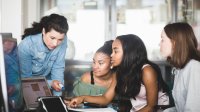An Exercise in Digital Storytelling
Digital media can be a good way for students to explore interpretations of a literary work, and to tell their own story.
Your content has been saved!
Go to My Saved Content.To engage my 11th-grade English students during the 2020–21 school year, I created a digital storytelling unit. Whether they attended school in person or remotely, it was a success. Students were able to explore various frames of reference, identify a personal story to share using digital media, and experience empathy throughout the process. Digital storytelling has a permanent place in my classroom.
Getting Started
As an initial activity, students analyzed “A Noiseless Patient Spider,” by Walt Whitman. After they made their own analyses, they viewed three different digital representations and readings of the poem. As they experienced each visual depiction, students answered a few guiding questions:
- How is the story told?
- What elements/strategies contribute to the story being told?
- Which one do you prefer?
This activity demonstrated how an author can convey their message through digital media and intonation.
Avoiding a ‘Single Story’
After discussing the different depictions of Whitman’s poem, students viewed Chimamanda Ngozi Adichie’s TED Talk, “The Danger of a Single Story,” to experience a foundational understanding of how varied individual experiences make up frames of reference, a key element of empathy. Avoiding a single-story perspective enables students to identify a diversity of thought, perspectives, an onslaught of emotions, and empathy.
Students adopted a commonly agreed-upon definition of empathy: “the capacity to understand or feel what another person is experiencing from their frame of reference.” They explored the definition within various pieces of literature, answering whether the authors present a single-story perspective in their writing, including “My Father in English,” by Richard Blanco, and the micro-fiction piece “Witness,” by John Edgar Wideman. With some classes, I also incorporated poetry by Sonia Sanchez and Audre Lorde and a story by Junot Díaz.
Students then rewrote a moment from any piece of literature we read, first reanalyzing the literature for frames of reference. Whose perspective does the author represent? What authorial choices communicate the perspective? What’s another possible perspective the author could have used to tell this story? By identifying the perspective and emotions that the students wished to convey, their selected rewritten moment would avoid reducing the character(s) to a single story.
Examining Identities
Next, to further explore elements associated with empathy and varied frames of reference, students examined literature and artwork through a perspective from an identity that differed from their own. For the Identity Resource Activity, students self-identified aspects of their own identity; I then asked them to select a different perspective to explore. I provided a list of potential resources (poetry, artwork, music, information about artists) for the following: Latino, Native American, Black (Haitian, Jamaican, for example), African-American, LGBTQ, Asian American, Southeast Asian, Pacific Islander, Muslim faith and Islamic culture, Jewish faith and culture.
Students could also identify another identity, if they chose to. Students completed a reflection related to their understanding of the new frame of reference.
Telling a Story—With a Digital Element
For the unit’s culminating assessment, students identified their own story to share, with an intended frame of reference to communicate to the audience, using a digital medium. To teach the foundational storytelling elements, the Moth gave me permission to access their curricular materials. The Moth is a nonprofit organization, located in New York City, that focuses on the art of storytelling. I implemented their resources, including example storytelling by high school–age young adults such as the Moth EDU episode “Hot Wheels.”
After analyzing the storytelling elements within several examples, I provided my own personal storytelling model, using the Moth’s storytelling elements, for students’ analyses. I shared my planner and my presentation, telling the story of the first time I jumped off the high diving board at the Pines Hotel in New York when I was 7. The digital element of my presentation included childhood photos of me jumping off the board, as well as a photo of my grandmother who led our yearly trips.
This allowed students to see my planned frame of reference and give me feedback about the empathy they experienced as audience members.
Students’ final presentations included a student-selected digital element; some incorporated multiple or single photos, or videos. As students listened to their peers’ presentations, they identified the degree to which they felt they understood the storyteller’s frame of reference. When I reviewed the results, the majority of students’ responses indicated a high level of understanding of their peers’ frame of reference.
Applying frames of reference to personal stories connected students so that they could have a better understanding of their peers’ frames of reference, along with my own. Examining frames of reference allows students to experience empathy in a new way.
As we return to class, digital storytelling can give students access to different interpretations of an art form and enable them to explore the concept of empathy through literature, art, and music.
